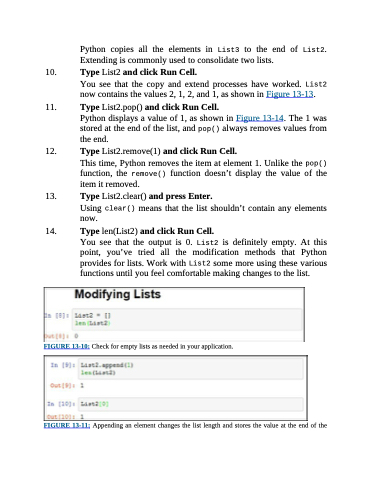Page 304 - Beginning Programming with Pyth - John Paul Mueller
P. 304
Python copies all the elements in List3 to the end of List2. Extending is commonly used to consolidate two lists.
10. Type List2 and click Run Cell.
You see that the copy and extend processes have worked. List2
now contains the values 2, 1, 2, and 1, as shown in Figure 13-13.
11. Type List2.pop() and click Run Cell.
Python displays a value of 1, as shown in Figure 13-14. The 1 was stored at the end of the list, and pop() always removes values from the end.
12. Type List2.remove(1) and click Run Cell.
This time, Python removes the item at element 1. Unlike the pop() function, the remove() function doesn’t display the value of the item it removed.
13. Type List2.clear() and press Enter.
Using clear() means that the list shouldn’t contain any elements
now.
14. Type len(List2) and click Run Cell.
You see that the output is 0. List2 is definitely empty. At this point, you’ve tried all the modification methods that Python provides for lists. Work with List2 some more using these various functions until you feel comfortable making changes to the list.
FIGURE 13-10: Check for empty lists as needed in your application.
FIGURE 13-11: Appending an element changes the list length and stores the value at the end of the


